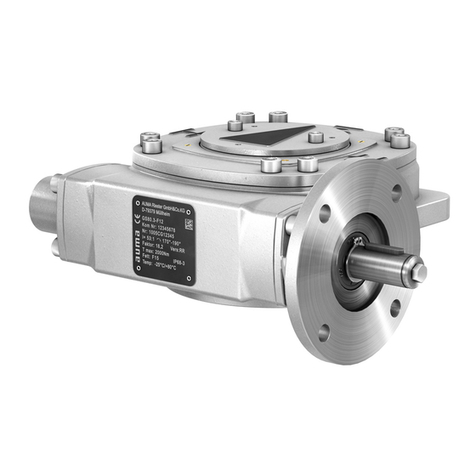AUMA FQM User manual

Fail safe unit
FQM 05.1 –FQM 12.1
FQMEx 05.1 –FQMEx 12.1
Assembly and commissioningOperation instructions

Read operation instructions first.
●Observe safety instructions.
●These operation instructions are part of the product.
●Store operation instructions during product life.
●Pass on instructions to any subsequent user or owner of the product.
Target group:
This document contains information for assembly, commissioning and maintenance staff.
Table of contents Page
41. Safety instructions................................................................................................................. 41.1. Basic information on safety 51.2. Range of application 51.3. Warnings and notes 51.4. References and symbols 61.5. Safety instructions for the handwheel
72. Identification........................................................................................................................... 72.1. Name plate 92.2. Short description
103. Transport, storage and packaging........................................................................................ 103.1. Transport 113.2. Storage 113.3. Packaging
124. Assembly................................................................................................................................ 124.1. Mounting position 134.2. Actuators for fail safe units 134.3. Fail safe unit:mount to valve 134.3.1. Overview on coupling variants 134.3.1.1. Fail safe unit to valve: mount
175. Electrical connection............................................................................................................. 175.1. Basic information 175.2. Electrical connection/actuator controls 175.3. Electrical connection for fail safe unit 185.3.1. KP/KPH electrical connection 185.3.1.1. Terminal compartment: open 195.3.1.2. Cable connection 205.3.1.3. Terminal compartment: close 215.3.2. S/SH electrical connection (AUMA plug/socket connector) 215.3.2.1. Terminal compartment: open 225.3.2.2. Cable connection 235.3.2.3. Terminal compartment: close
246. Commissioning...................................................................................................................... 246.1. Initialisation 256.2. End stops in the fail safe unit 266.2.1. End stop CLOSED: set 266.2.2. End stop OPEN: set 266.3. Reference operation (adaptive end position setting)
2
FQM 05.1 –FQM 12.1 / FQMEx 05.1 –FQMEx 12.1
Table of contents

287. Fail safe operation and standard operation.........................................................................
298. Indications.............................................................................................................................. 298.1. Indications on display 298.1.1. Indications during and after initialisation 298.1.2. Indications during fail safe operation 308.2. Indication lights of local controls 308.2.1. Indication lights (indications): modify
319. Signals (output signals)......................................................................................................... 319.1. Status signals via output contacts (digital outputs) 319.1.1. Assignment of outputs 319.1.2. Direct feedback signals from the fail safe unit
3210. Technical data......................................................................................................................... 3210.1. Technical data fail safe unit
34Index........................................................................................................................................
3
FQM 05.1 –FQM 12.1 / FQMEx 05.1 –FQMEx 12.1 Table of contents

1. Safety instructions
1.1. Basic information on safety
Standards/directives Our products are designed and manufactured in compliance with recognised
standards and directives.This is certified in a Declaration of Incorporation and an
EU Declaration of Conformity.
The end user or the contractor must ensure that all legal requirements, directives,
guidelines, national regulations and recommendations with respect to assembly,
electrical connection, commissioning and operation are met at the place of installation.
They include among others standards and directives such as IEC 60079 “Explosive
atmospheres"
●Part 14: Electrical installations design, selection and erection.
●Part 17: Electrical installations inspection and maintenance.
Safetyinstructions/warn-
ings All personnel working with this device must be familiar with the safety and warning
instructions in this manual and observe the instructions given. Safety instructions
and warning signs on the device must be observed to avoid personal injury or property
damage.
Qualification of staff Assembly, electrical connection, commissioning, operation, and maintenance must
be carried out by suitably qualified personnel authorised by the end user or contractor
of the plant only.
Prior to working on this product, the staff must have thoroughly read and understood
these instructions and, furthermore, know and observe officially recognised rules
regarding occupational health and safety.
Work performed in potentially explosive atmospheres is subject to special regulations
which have to be observed.The end user or contractor of the plant are responsible
for respect and control of these regulations, standards, and laws.
Commissioning Prior to commissioning, it is important to check that all settings meet the requirements
of the application. Incorrect settings might present a danger to the application, e.g.
cause damage to the valve or the installation.The manufacturer will not be held
liable for any consequential damage. Such risk lies entirely with the user.
Operation Prerequisites for safe and smooth operation:
●Correct transport, proper storage, mounting and installation, as well as careful
commissioning.
●Only operate the device if it is in perfect condition while observing these instruc-
tions.
●Immediately report any faults and damage and allow for corrective measures.
●Observe recognised rules for occupational health and safety.
●Observe national regulations.
●During operation, the housing warmsupandsurface temperatures > 60 °C may
occur.To prevent possible burns, we recommend checking the surface temper-
ature using an appropriate thermometer and wearing protective gloves, if re-
quired, prior to working on the device.
Protective measures The end user or the contractor are responsible for implementing required protective
measures on site, such as enclosures, barriers, or personal protective equipment
for the staff.
Maintenance Maintenance and service actions must be exclusively performed by appropriately
trained and authorised staff.
During maintenance intervention on fail safe unit, the references regarding
maintenance specified in the operation instructions pertaining to actuator must be
obeyed.
Any device modification requires prior written consent of the manufacturer.
4
FQM 05.1 –FQM 12.1 / FQMEx 05.1 –FQMEx 12.1
Safety instructions

Opening covers or unfastening screws is only permitted if the pertaining description
is available in the operation instructions.
1.2. Range of application
The FQM fail safe unit is designed for emergency operation of industrial valves, e.g.
globe valves, butterfly valves, and ball valves.The unit is operated in combination
with an AUMA part-turn actuator.
Other applications require explicit (written) confirmation by the manufacturer.
The FQMEx devices are approved for use in the potentially explosive atmospheres
of zones 1, 2, 21, and 22.
The following applications are not permitted, e.g.:
●Buried service
●Continuous submersion (observe enclosure protection)
●Potentially explosive areas of zones 0 and 20
●Potentially explosive areas of group I (mining)
●Radiation exposed areas in nuclear power plants
●pulling loads (such as shutter weirs, fish-belly flap gate, and sluice gates, etc.)
No liability can be assumed for inappropriate or unintended use.
Observance of these operation instructions is considered as part of the device's
designated use.
Information These instructions apply to the standard version “clockwise closing”, i.e.the driven
shaft turns clockwise to close the valve.
1.3. Warnings and notes
The following warnings draw special attention to safety-relevant procedures in these
operation instructions, each marked by the appropriate signal word (DANGER,
WARNING, CAUTION, NOTICE).
Indicates an imminently hazardous situation with a high level of risk. Failure
to observe this warning results in death or serious injury.
Indicates a potentially hazardous situation with a medium level of risk.Failure
to observe this warning could result in death or serious injury.
Indicates a potentially hazardous situation with a low level of risk. Failure to
observe this warning could result in minor or moderate injury. May also be
used with property damage.
Potentially hazardous situation. Failure to observe this warning could result
in property damage. Is not used for personal injury.
Safety alert symbol warns of a potential personal injury hazard.
The signal word (here: DANGER) indicates the level of hazard.
1.4. References and symbols
The following references and symbols are used in these instructions:
Information The term Information preceding the text indicates important notes and information.
Symbol for CLOSED (valve closed)
Symbol for OPEN (valve open)
5
FQM 05.1 –FQM 12.1 / FQMEx 05.1 –FQMEx 12.1 Safety instructions

➥Result of a process step
Describes the result of a preceding process step.
1.5. Safety instructions for the handwheel
Turning handwheel at actuator following a fail safe operation!
Risk of hand injury for handwheels equipped with ball handle.
→Following a fail safe operation, do NOT activate manual operation.
→This means, for all interventions, the push button at the actuator handwheel
must NOT be pressed prior to initialisation.
Information Successful initialisation is indicated with FQM FS ready on the actuator display.The
symbol is displayed in the status bar (top). Further information on initialisation: ➭
page 24, Initialisation
6
FQM 05.1 –FQM 12.1 / FQMEx 05.1 –FQMEx 12.1
Safety instructions

2. Identification
2.1. Name plate
Figure 1: Arrangement of name plates
[1] Fail safe unit name plate
[2] Additional plate, e.g. KKS plate (Power Plant Classification System)
[3] Explosion protection approval plate
Actuator name plate
Figure 2: Fail safe unit name plate (example)
[1] Name of manufacturer
[2] Address of manufacturer
[3] Type designation
[4] Order number
[5] Actuator serial number
[6] Nominal operating time in [s] for a part-turn movement of 90°
[7] Max. torque in direction OPEN/CLOSE
[8] Type of lubricant
[9] Permissible ambient temperature
[10] Mains voltage, mains frequency
[11] Control
[12] Can be assigned as an option upon customer request
[13] Power
[14] Enclosure protection
[15] FQM fail safe direction
[16] Data Matrix code
7
FQM 05.1 –FQM 12.1 / FQMEx 05.1 –FQMEx 12.1 Identification

Approval plate in explosion-proof version
Figure 3: Approval plates in explosion-proof version (examples)
[1] Ex symbol, CE mark, ID of test authority
[2] Ex certificate (number)
Classification:
[3] Electrical gas explosion protection
[4] Threads for cable entries at electrical connection
Description referring to name plate indications
Type designation Figure 4:Type designation (example)
1. Type and size of fail safe actuator
2. Flange size
3. Ex marking
Type and size
These instructions apply to the following devices types and sizes:
Fail safe unit of FQM type, sizes 05.1, 07.1, 10.1, 12.1
Fail safe unit of FQMEx type, sizes 05.1, 07.1, 10.1, 12.1
Ex marking
Table 1:
Marking for explosion protection (with example /––3 ––)
––3––/
Not used–
Not used–
Protection type of electrical connection
3 = Terminal compartment Ex eincreased safety
4 = Terminal compartment Ex dflameproof enclosure
3
Not used–
Not used–
Order number The product can be identified using this number and the technical data as well as
order-related data pertaining to the device can be requested.
Please always state this number for any product inquiries.
On the Internet at http://www.auma.com > Service & Support >myAUMA, we offer
a service allowing authorised users to download order-related documents such as
wiring diagrams and technical data (bothin German and English),inspection certificate
and the operation instructions when entering the order number.
8
FQM 05.1 –FQM 12.1 / FQMEx 05.1 –FQMEx 12.1
Identification

Serial number of Table 2:
Description of serial number (example of 0518WQ12345)
WQ123451805
Assembly in week:05 = week 505
Year of manufacture ; 18 = 201818
Internal number for unambiguous product identificationWQ12345
FQM fail safe direction Direction of rotation of FQM output drive shaft or the driven valve shaft when safety
function is triggered.
●CW = Clockwise rotation
●CCW = Counterclockwise rotation
Fail safe OPEN and fail safe CLOSE safety functions result from the overall
combination of actuator (gearbox), FQM and valve.
Table 3:
Safety function
Safety functionFQM fail safe directionValve closing direction (actuator)1)
Fail safe CLOSEClockwise
CW
Clockwise closing
Fail safe OPENCounterclockwise
CCW
Clockwise closing
Fail safe OPENClockwise
CW
Counterclockwise closing
Fail safe CLOSECounterclockwise
CCW
Counterclockwise closing
For identical closing direction of valve and actuator1)
Data Matrix code Whenregistered as authoriseduser,youmay use ourAUMA Assistant App to scan
the Data Matrix code and directly access the order-related product documents without
having to enter order number or serial number.
Figure 5: Link to AUMA Assistant App:
For further Service & Support, Software/Apps/...refer to www.auma.com
2.2. Short description
In emergencies, the fail safe unit is capable of closing or opening the valve
autonomously relying on mechanical functions.No electrical power is required for
such a fail safe operation.The torque required for opening or closing the valve is
generated by a constant force spring motor, providing a constant torque across the
total travel during fail safe operation.Consequently, the torque value for a fail safe
operation is determined by the available torque of the fail safe unit and is independent
from the actuator torque range.
For standard valve operation, the FQM fail safe unit is combined with an AUMA SQ
part-turn actuator.The required torque is transmitted directly from the actuator through
the fail safe unit to the valve. During standard operation, the constant force spring
motor of the fail safe unit is disengaged and is not operated.
The operating speed for the fail safe operation can be set in the factory.Furthermore,
the actuator operates the valve into the defined end position at reduced speed.This
avoids pressure peaks within the pipeline and protects the valve.
9
FQM 05.1 –FQM 12.1 / FQMEx 05.1 –FQMEx 12.1 Identification

3. Transport, storage and packaging
3.1. Transport
For transport to place of installation, use sturdy packaging.
Suspended load!
Risk of death or serious injury.
→Do NOT stand below suspended load.
→Attach lifting accessories for the purpose of lifting by hoist only to housing and
NOT to handwheel.
→Check eyebolts for tight seat in housing (verify reach of the screws).
→Observe manufacturer specifications for fixing lifting straps and round slings.
→Heed total weight of arrangement.
Figure 6: Example, fixing FQM 07.1 with actuator and actuator actuator controls
Table 4:
Weights for fail safe unit
approx. [kg]Type
61FQM 05.1/FQMEx 05.1
64FQM 07.1/FQMEx 07.1
135FQM 10.1/FQMEx 10.1
137FQM 12.1/FQMEx 12.1
10
FQM 05.1 –FQM 12.1 / FQMEx 05.1 –FQMEx 12.1
Transport, storage and packaging

Table 5:
Weights for actuators and actuator controls1)
approx. [kg]Type
Part-turn actuator
21/29SQ 05.2/SQEx 05.2
21/29SQ 07.2/SQEx 07.2
26/34SQ 10.2/SQEx 10.2
35/42SQ 12.2/SQEx 12.2
Actuator controls
7/12AC01.2/ACExC 01.2
Indicated weights apply to actuators with 3-phase AC motors, standard output drive and standard
electrical connection.Weights for actuator controls with standard electrical connection.
1)
3.2. Storage
Danger of corrosion due to inappropriate storage!
→Store in a well-ventilated, dry room (maximum humidity 70 %).
→Protect against floor dampness by storage on a shelf or on a wooden pallet.
→Cover to protect against dust and dirt.
→Apply suitable corrosion protection agent to uncoated surfaces.
Risk of damage due to excessively low temperatures!
→Actuator controls may only be stored permanently down to –30 °C.
→On request, actuators controls may be transported in specific cases and for
short duration at temperatures down to –60 °C.
Long-term storage For long-term storage (more than 6 months), observe the following points:
1. Prior to storage:
Protect uncoated surfaces, in particular the output drive parts and mounting
surface, with long-term corrosion protection agent.
2. At an interval of approx. 6 months:
Check for corrosion.If first signs of corrosion show, apply new corrosion protec-
tion.
3.3. Packaging
Our products are protected by special packaging for transport when leaving the
factory.The packaging consists of environmentally friendly materials which can easily
be separated and recycled.We use the following packaging materials: wood,
cardboard, paper, and PE foil. For the disposal of the packaging material, we
recommend recycling and collection centres.
11
FQM 05.1 –FQM 12.1 / FQMEx 05.1 –FQMEx 12.1 Transport, storage and packaging

4. Assembly
4.1. Mounting position
The product described in this document can be operated in any mounting position.
For horizontal mounting position, the fail safe unit requires reinforcement to relieve
the flange connection to the valve.
Figure 7: Reinforcement for horizontal mounting position (example)
The reinforcement is made at both threads provided for transport.For FQM 05.1/07.1
= M10 thread; for FQM 10.1/12.1 = M12 thread.
We recommend glueing the screws using thread sealing material to avoid contact
corrosion in the thread.
To compensate for vibration, we recommend using additional all-metal cushions as
available with Stop-Choc ®.
Support by AUMA AUMA offers an own support.The support is fixed at the output drive flange using
suitable fastening clamps.It includes all-metal dampers to compensate for vibration.
Figure 8: Support by AUMA (example)
12
FQM 05.1 –FQM 12.1 / FQMEx 05.1 –FQMEx 12.1
Assembly

4.2. Actuators for fail safe units
An AUMA actuator with integral controls combination is required to operate the valve
via fail safe unit.On delivery, the actuator is already mounted to the fail safe unit.
Information ●Assembly of disassembly of actuators should only be performed by the AUMA
Service.
●The mounted SQ part-turn actuator is not equipped with end stops.The part-
turn actuator screw plugs do not have any function and should not be opened.
4.3. Fail safe unit: mount to valve
The fail safe unit is mounted to the valve using a coupling placed onto the valve
shaft.
4.3.1. Overview on coupling variants
Design Figure 9:Valve attachment via coupling
[1] Bore with keyway
[2] Square bore
[3] Bore with two-flats
Application ●For valve attachments according to EN ISO 5211
●For rotating, non-rising valve stem
4.3.1.1. Fail safe unit to valve: mount
Unbored couplings or couplings with pilot bore must be machined to match the valve
shaft prior to mounting the fail safe unit to the valve (e.g.with bore and keyway,
two-flat or square bore).
Information ●Assemble valve and fail safe unit in the same end position (OPEN/CLOSED).
●Only mount fail safe unit with unwound constant force spring. Make sure that
unit is not live.
●While constant force spring is unwound, the fail safe unit is set to the end posi-
tion of the fail safe direction indicated on the name plate:
-CW ≙end position CLOSED (for clockwise rotating valve)
-CCW ≙end position OPEN (for clockwise rotating valve)
Assembly steps 1. Clean and thoroughly degrease mounting surfaces of output mounting flanges.
2. Apply a small quantity of grease to the valve shaft [2].
13
FQM 05.1 –FQM 12.1 / FQMEx 05.1 –FQMEx 12.1 Assembly

3. Place coupling [1] onto valve shaft [2] and secure against axial slipping by using
a grub screw [3] or a washer and a screw [4].Thereby, ensure that dimensions
X,Y or L are observed (refer to figure and table <Mounting positions for coup-
ling>).
Figure 10: Examples: Fit coupling
[1] Coupling
[2] Valve shaft
[3] Grub screw
[4] Screw with washer
Figure 11: Mounting positions for coupling
Table 6: FQM 12.1FQM 10.1FQM 07.1FQM 05.1Dimensions
[mm]
F14F12F12F10F10F07F07EN ISO 5211
6666555X max.
10101010555Y max.
1006060100454545L max.
4. Apply non-acidic grease at splines of coupling (e.g.Gleitmo by Fuchs).
14
FQM 05.1 –FQM 12.1 / FQMEx 05.1 –FQMEx 12.1
Assembly

5. Place fail safe unit onto valve coupling and make sure that the screws match
the bores provided.
➥For CW version, the FQM bores [ ] should overlap the bores of the valve flange
[ ] rather in clockwise direction.
Figure 12: Place FQM on valve coupling (CW version)
[ ] FQM bore
[ ] Valve flange bore
[1] Setting screw
[2] View on valve flange and rotary movement of FQM when unfastening
the setting screw.
➥For CCW version, the FQM bores [ ] should overlap the bores of the valve
flange [ ] rather in counterclockwise direction.
Figure 13: Place FQM on valve coupling (CCW version)
[ ] FQM bore
[ ] Valve flange bore
[1] Setting screw
[2] View on valve flange and rotary movement of FQM when unfastening
the setting screw.
15
FQM 05.1 –FQM 12.1 / FQMEx 05.1 –FQMEx 12.1 Assembly

6. Should the bores for the screws not align:
→Remove screw plug and sightly unfasten setting screw [1] for end stop
OPEN/CLOSED at fail safe unit counterclockwise until bores [ ] line
up.When unfastening the setting screw, the FQM moves back in direction
of the valve flange bore [ ].
Risk of setting screw falling out!
→Avoid excessive unscrewing of setting screws.Observe dimensionTmin.! Refer
to:Risk of damage to end stop if setting screw is turned against the spring force.
page 25, End stops in the fail safe unit
→Do NOT unscrew setting screw clockwise against the spring force (fastening).
7. Fasten fail safe unit with screws.
Information:We recommend glueing the screws using thread sealing material
(e.g.LOCTITE 243) to avoid thread contact corrosion and to ensure vibration
resistance.
8. Fasten screws crosswise to a torque according to table.
Table 7:
Tightening torques for screws
Tightening torque [Nm]Threads
Strength class A2-80/A4–80
10M6
24M8
48M10
82M12
200M16
392M20
Information Ifthe bores [ ]are notyetalignedfordimensionTmin.,the mounting procedure must
be aborted.The following steps have to be performed:
1. Remove fail safe unit from valve.
2. Establish electrical connection and connect to power supply.
Once the power supply is connected, initialisation is started provided all pre-
requisites are fulfilled. ➭page 24, Initialisation
3. After initialisation, screw the setting screw to dimensionT(at90) (without tolerance
margin indicated). ➭page 25, End stops in the fail safe unit
4. Then, switch off power supply again (de-energize).
The actuator performs a fail safe operation and moves to the configured fail
safe end position.
5. Now, re-place the valve onto the fail safe unit and mount to the valve as de-
scribed in the present chapter.
When mounting the fail safe unit onto the valve coupling, select splines as to
ensure that bores of the screws for the FQM and the valve flange are as close
as possible.
16
FQM 05.1 –FQM 12.1 / FQMEx 05.1 –FQMEx 12.1
Assembly

5. Electrical connection
5.1. Basic information
Hazardous voltage!
Risk of electric shock.
→Disconnect device from the mains before opening.
→When operating in potentially explosive atmospheres:Prior to opening, ensure
absence of gas and voltage.
Danger due to incorrect electrical connection
Failure to observe this warning can result in death, serious injury, or property damage.
→The electrical connection must be carried out exclusively by suitably qualified
personnel.
Wiring diagram/terminal
plan The pertaining wiring diagram/terminal plan (in German or English) is attached to
the device in a weather-proof bag, together with these operation instructions. It can
also be requested from AUMA (state order number, refer to name plate) or
downloaded directly from the Internet (http://www.auma.com).
Protection on site For short-circuit protection and for disconnecting from the mains, fuses and disconnect
switches have to be provided by the customer.
The current values for respective sizing are derived from the current consumption
of the motor (refer to electrical data sheet), the current consumption of the actuator
controls, plus the current consumption of the fail safe unit. Please refer to the
operation instructions pertaining to the actuator for information on the current
consumption of actuator controls.
When providing joint protection for actuator, actuator controls and fail safe unit, the
maximum power consumption of 360 W for the fail safe unit has to be accounted
for. In case separate power supply for the fail safe unit is provided, 360 W have to
be accounted for FQM protection.
Consider increased power supply starting current when selecting the circuit breaker
characteristic.We recommend tripping characteristics D or K for circuit breakers in
accordance with IEC 60947-2.To avoid spurious action, fuses with values below 2
A are not recommended.
5.2. Electrical connection/actuator controls
The customer connection for valve control during standard operation (power
connection and signal cables) is made via the electrical connection of the actuator
or the actuator controls.Any procedures for opening/closing the terminal compartment
and for connecting the cables are described in the Operation instructions pertaining
to the actuator.
5.3. Electrical connection for fail safe unit
On delivery, the electrical connection of the fail safe unit is already equipped with
the power supply cable for FQM and the signal cable for actuator controls.
The tripping signal (ESD) for a fail safe operation as well as direct feedbacks (e.g.
LSO/LSC end position switch signals) have to be connected in compliance with the
wiring diagram at the customer’s.
Depending on the application, either an S type electrical connector (weatherproof
environment) or a KP type electrical connector (explosion-proof environment) will
be provided.
17
FQM 05.1 –FQM 12.1 / FQMEx 05.1 –FQMEx 12.1 Electrical connection

5.3.1. KP/KPH electrical connection
5.3.1.1. Terminal compartment: open
Figure 14: Open terminal compartment
[1] Cover (figure shows KP version)
[2] Screws for cover
[3] O-ring
[4] Reducing socket
[5] Cable gland
[6] Flameproof frame
Electric shock due to presence of hazardous voltage!
Failure to observe this warning results in death or serious injury.
→Disconnect device from the mains before opening.
1. Loosen screws [2] and remove cover [1].
Information: The terminal compartment is designed in protection type Ex e
(increased safety).The interior of the flameproof enclosure (Ex d) of connected
housing remains closed when removing the cover [1].
2. Insert cable glands suitable for connecting cables.
Information:When selecting cable glands observe type of protection (with Ex e
approval) and enclosure protection IP.
The enclosure protection IP…stated on the name plate is only ensured if
suitable cable glands are used.
Figure 15: Name plate, example with enclosure protection IP68
3. Seal unused cable entries with approved plugs suitable for the required protec-
tion type.
18
FQM 05.1 –FQM 12.1 / FQMEx 05.1 –FQMEx 12.1
Electrical connection

5.3.1.2. Cable connection
Table 8:
Terminal cross sections and terminal tightening torques
Tightening torquesTerminal cross sectionsDesignation
0.9 –1.1 NmWith small clamp washers:
1.5 –4.0 mm2(flexible or solid)
Power contacts (U1,V1, W1)
Protective earth connection (PE) With large clamp washers:
2.5 –6 mm2(flexible or solid)
0.5 –0.7 Nm0.75 –1.5 mm2(flexible or solid)Control contacts
(1 to 24, 31 to 40, 47 to 50, PE)
1. Remove cable sheathing in a length of 120 –140 mm.
2. Insert the cable into the cable glands.
3. Fasten cable gland with the specified torque to ensure required enclosure pro-
tection.
4. Remove wire sheathing in a length of approx. 8 mm.
5. For flexible cables: Use end sleeves according to DIN 46228.
6. Connect cables according to order-related wiring diagram.
Information: Two wires for each connection permitted.
In case of a fault: Hazardous voltage while protective earth conductor is NOT
connected!
Risk of electric shock.
→Connect all protective earth conductors.
→Connect PE connection to external protective earth conductor of connecting
cables.
→Start running the device only after having connected the protective earth con-
ductor.
7. Firmly tighten protective earth at PE connection of KP electrical connection.
8. Connect equipotential earth bonding at external earth connection for equipoten-
tial compensation (U-bracket with symbol )
Figure 16: External earth connection
Table 9:
Terminal cross sections and earth connection tightening torques
Tightening torquesTerminal cross sectionsConductor type
3 –4 Nm2.5 mm² to 6 mm²Solid wire and stranded
3 –4 Nm1.5 mm² to 4 mm²Fine stranded
For fine stranded (flexible) wires, connection is made via cable lugs/ring terminals.When connecting
two individual wires with a U-bracket, cross sections have to be identical.
19
FQM 05.1 –FQM 12.1 / FQMEx 05.1 –FQMEx 12.1 Electrical connection

5.3.1.3. Terminal compartment: close
Figure 17: Close terminal compartment
[1] Cover (figure shows KP version)
[2] Screws for cover
[3] O-ring
[4] Cable gland
[5] Flameproof frame
1. Clean sealing faces of cover [1] and frame [5].
2. Check whether O-ring [3] is in good condition, replace if damaged.
3. Apply a thin film of non-acidic grease (e.g.petroleum jelly) to the O-ring and
insert it correctly.
4. Fit cover [1] and fasten screws [2] evenly crosswise.
5. Fasten cable glands and blanking plugs applying the specified torque to ensure
the required enclosure protection.
Once the power supply is connect, initialisation is started provided all prerequisites
are fulfilled. ➭page 24, Initialisation
20
FQM 05.1 –FQM 12.1 / FQMEx 05.1 –FQMEx 12.1
Electrical connection
This manual suits for next models
1
Table of contents
Other AUMA Industrial Equipment manuals
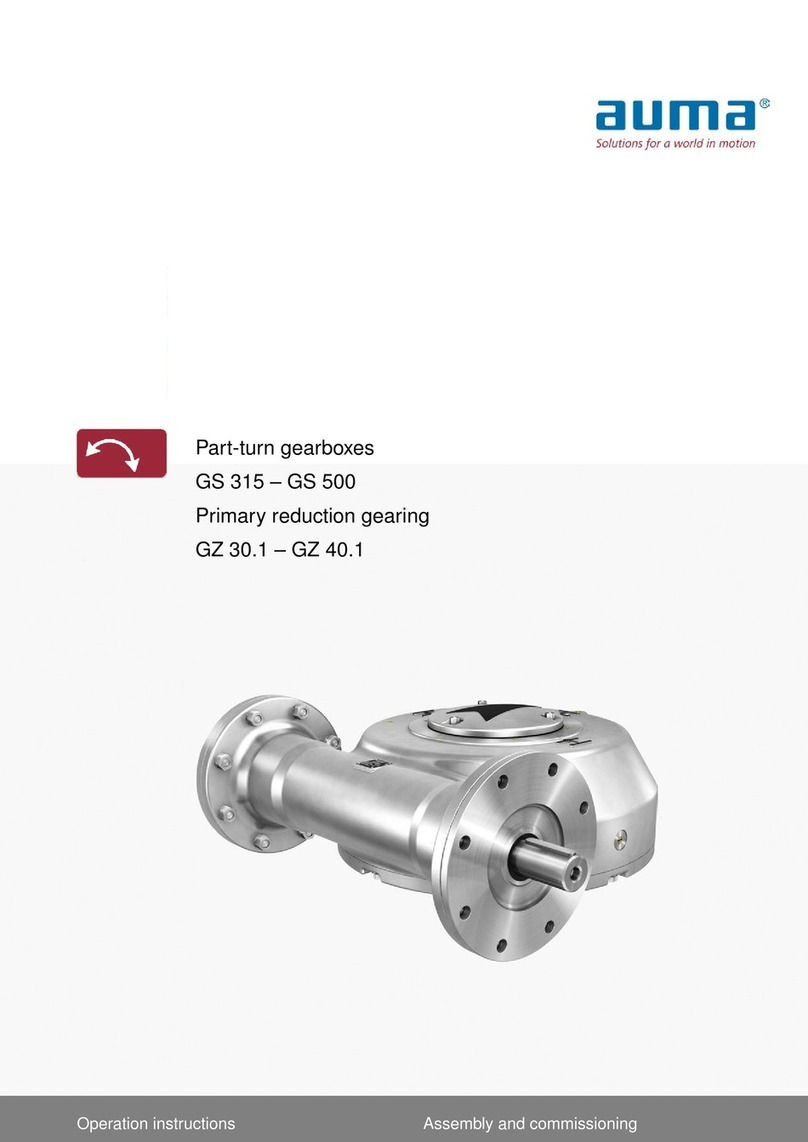
AUMA
AUMA GS 315 User manual
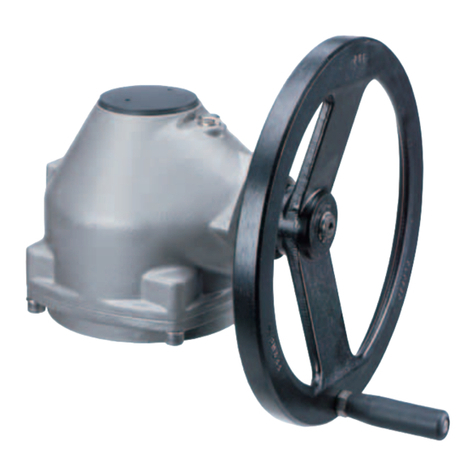
AUMA
AUMA GK 10.2 User manual
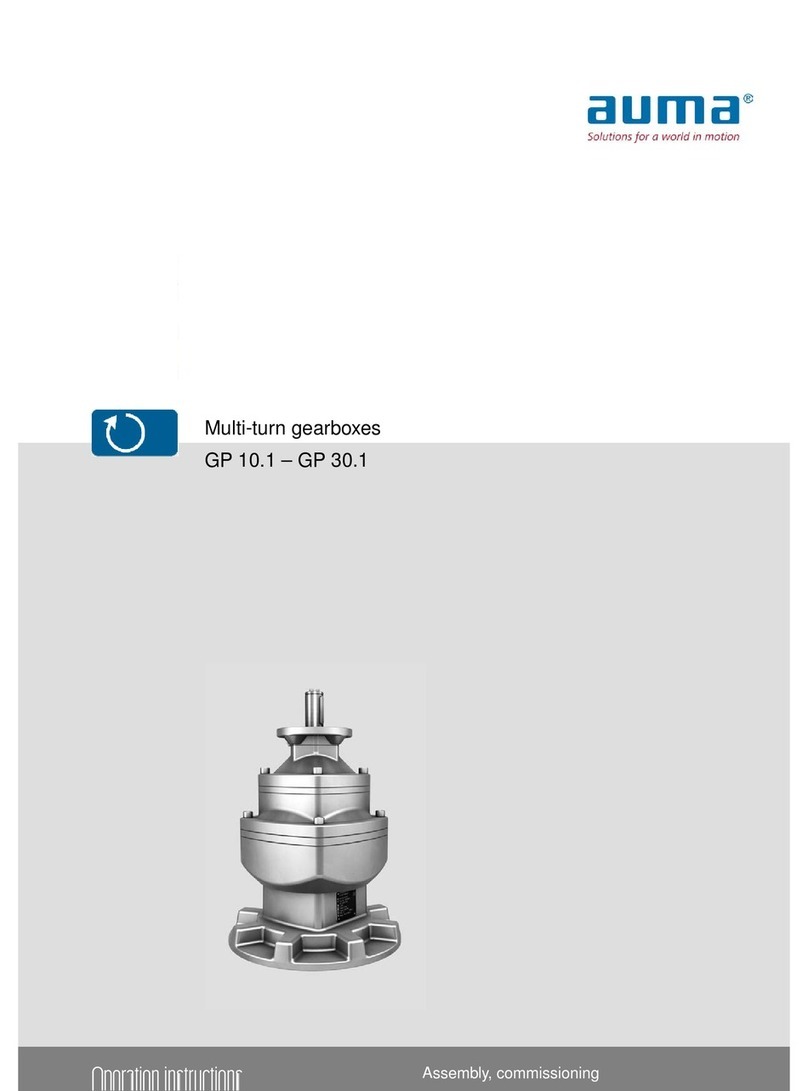
AUMA
AUMA GP 14.1 User manual
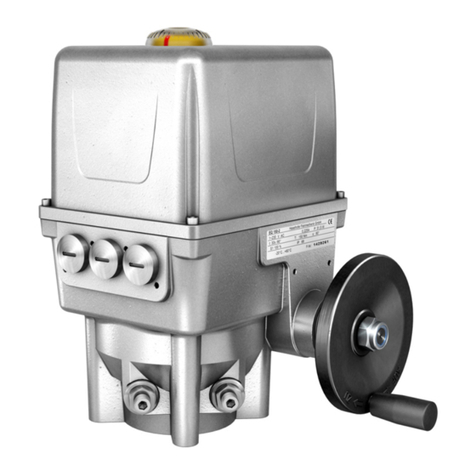
AUMA
AUMA EQ15-600 User manual
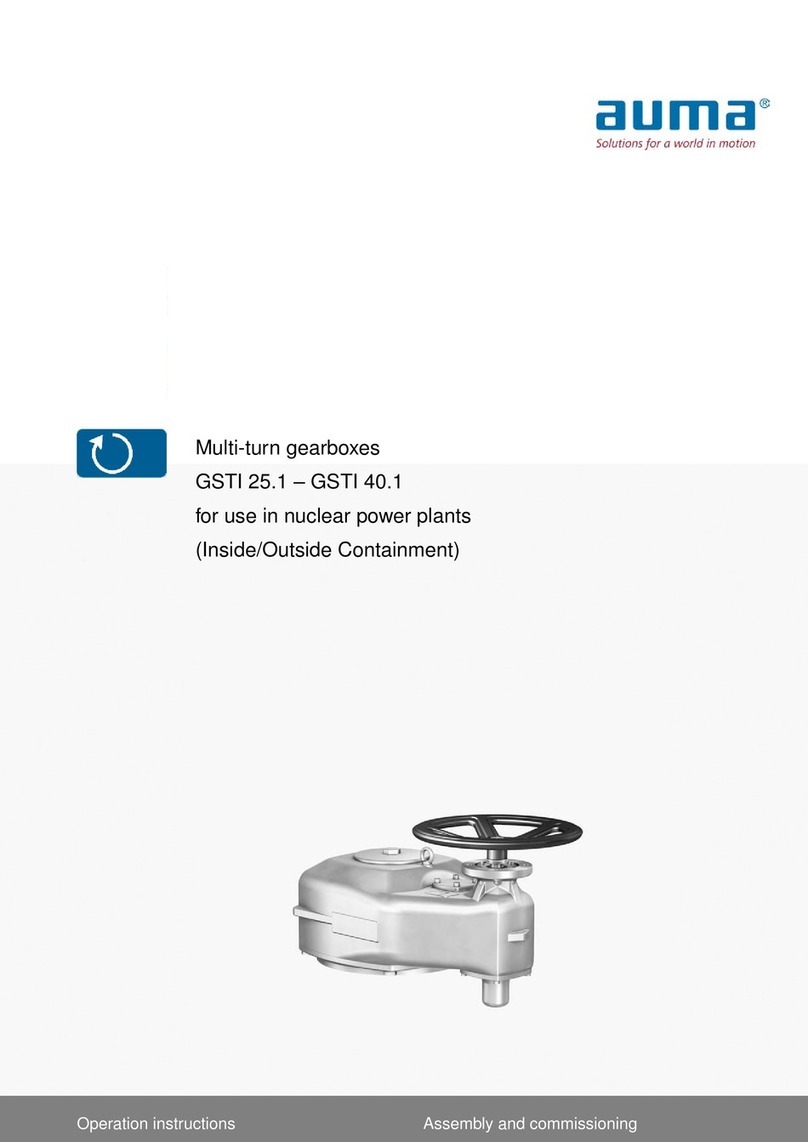
AUMA
AUMA GSTI 25.1 User manual
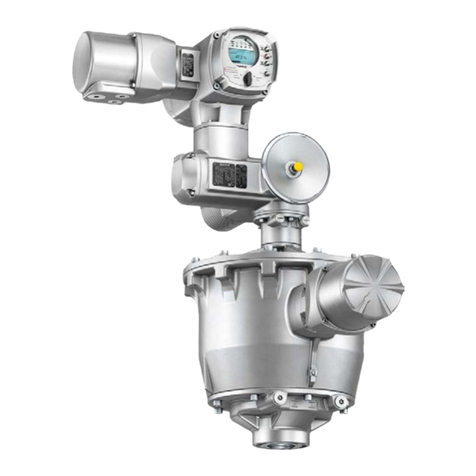
AUMA
AUMA FQMEx 05.1 User manual
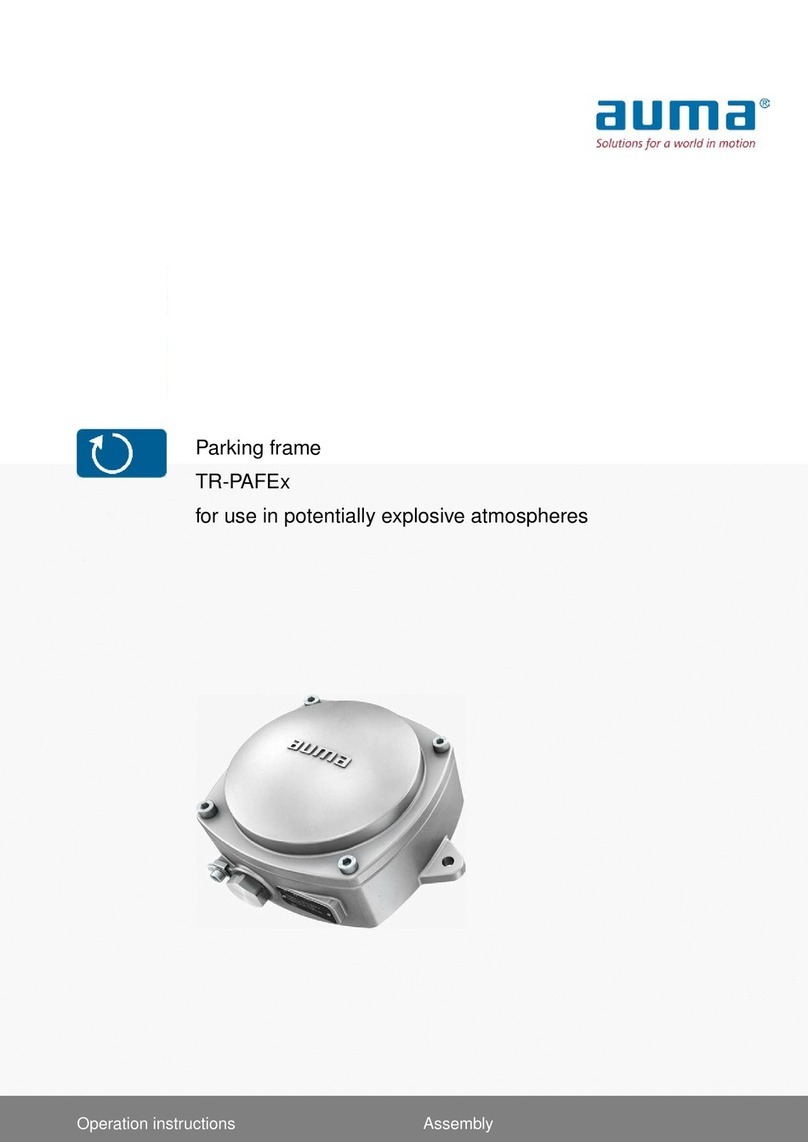
AUMA
AUMA TR-PAFE Series Technical manual
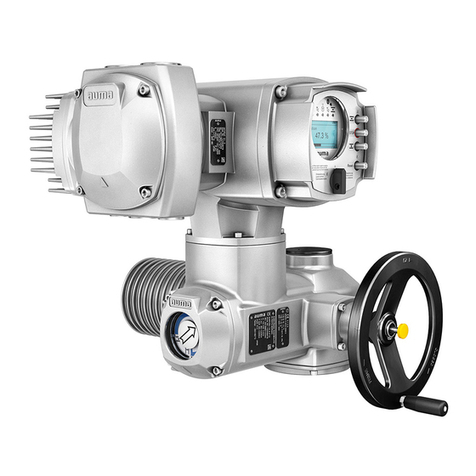
AUMA
AUMA SAVEx 07.2 User manual
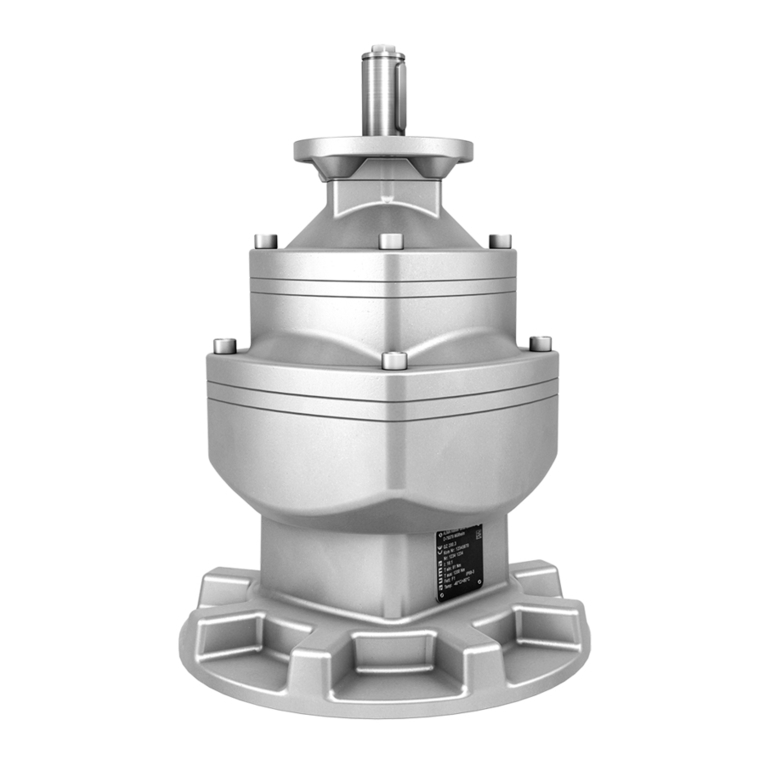
AUMA
AUMA GP 10.1 User manual

AUMA
AUMA GK 10.2 User manual
